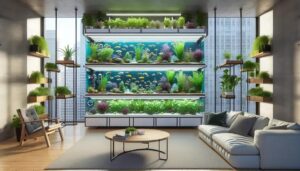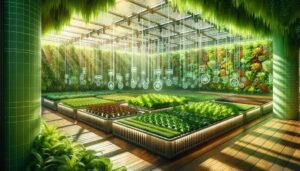Ever wondered how to grow fresh lettuce right at home? By using lettuce in indoor hydroponic window systems, you’re stepping into a world where fresh greens are just a window away. Let’s explore how these systems work and why they’re a game-changer for home gardening.
choosing the right hydroponic system for your windows
When selecting a hydroponic system for your windows, there are several factors to consider to ensure a successful indoor garden. First, assess the space available and the amount of natural light your windows receive. Choose a system that fits your specific environment, such as an ebb and flow system, nutrient film technique (NFT), or deep water culture (DWC). Each of these has different space and lighting requirements.
Considerations for System Size
The size of your hydroponic setup should match the amount of natural light coming through the window. Larger systems may need additional lighting, while smaller setups can thrive with just sunlight.
Compatibility with Windows
Some hydroponic systems are designed to maximize space by utilizing vertical or horizontal arrangements. Think about how the system will integrate with your window size and shape.
Additionally, consider the amount of maintenance you’re ready to handle. Simpler systems like wick systems might require less upkeep but offer limited yields, whereas more complex systems can produce more lettuce but need regular maintenance.
Budget and Cost
Your budget will also play a role in your decision. There are cost-effective solutions available for beginners that won’t compromise quality. Kits are often a good starting point as they include all necessary components.
setting up your indoor lettuce garden
Setting up an indoor lettuce garden can be a rewarding project, offering fresh produce year-round. Start by selecting a suitable space with ample natural light, or prepare to install grow lights if necessary. Containers or trays designed for hydroponics work best to hold your lettuce plants.
Preparing the Environment
Ensure your chosen spot has the right conditions for plant growth. A consistent temperature around 65°F to 70°F is ideal for lettuce. Consider adding a fan to promote air circulation and prevent mold.
Choosing Your Lettuce Varieties
Selecting the right lettuce variety is crucial. Leafy types such as butterhead, romaine, and oakleaf are great choices for hydroponic growth due to their smaller root systems and quick growth.
Fill your system’s reservoir with a nutrient-rich solution, ensuring it is well-mixed. Place seeds or seedlings into the system, spacing them adequately to prevent overcrowding as they grow.
Monitoring and Maintenance
Check water levels and nutrient balance regularly. Adjust the pH to keep it between 5.5 and 6.5, which is optimal for lettuce. Regular maintenance is key to ensuring healthy growth and bountiful harvests.
ideal conditions for lettuce growth indoors
To cultivate healthy lettuce indoors, maintaining ideal conditions is key. Lettuce thrives in temperatures ranging from 60°F to 70°F, making it well-suited for indoor environments where the climate can be controlled. Proper air circulation is also essential, as this helps prevent mold and ensures that plants receive enough carbon dioxide.
Light Requirements
Ample sunlight is crucial for lettuce growth; however, if natural light is limited, consider using LED grow lights to supplement. These lights should mimic sunlight and be kept on for about 12 to 16 hours a day.
Humidity and Watering
Humidity levels ideally should stay between 50% and 70%. Consistent watering is vital. Hydroponic systems simplify this by delivering the right amount of water and nutrients directly to the roots. Ensure the nutrient solution is well-balanced to provide all necessary minerals.
The pH level of the nutrient solution should be maintained between 5.5 and 6.5 to promote optimal nutrient uptake. Regular monitoring of these conditions will ensure your indoor lettuce thrives.
common challenges and how to overcome them
Growing lettuce indoors using hydroponic systems can offer several challenges, but with proper strategies, these can be overcome. One common issue is the presence of pests like aphids. Regularly inspect your plants and use natural pest control methods such as introducing beneficial insects or neem oil treatments.
Nutrient Deficiencies
Lettuce may show signs of nutrient deficiencies, which can be addressed by ensuring your hydroponic nutrient solution is balanced. Regularly check and adjust the nutrient levels, and ensure the pH is maintained between 5.5 and 6.5.
Water Quality and Algae Growth
Water quality is crucial in hydroponics. Use filtered water to prevent mineral buildup and adjust for the right pH. Algal growth is another challenge; it can be managed by covering tanks and pipes to block light and clean your system regularly.
Lighting is another common issue. Insufficient light can stunt growth. Ensure your lettuce receives enough light, either naturally or via LED grow lights for 12 to 16 hours a day.
cost-effective solutions for beginners
Starting a hydroponic window garden can be a cost-effective way to enjoy fresh lettuce at home. For beginners, choosing affordable materials is key. Many basic setups can be created using recycled containers, which serve as excellent plant holders.
DIY Hydroponic Systems
Consider making a simple DIY system using items like plastic storage bins or 2-liter bottles. These are easily available and can be adapted to fit various spaces.
Inexpensive Nutrient Solutions
Purchase a basic hydroponic nutrient mix, which is often cheaper when bought in bulk. Alternatively, you can make your own using common household items like Epsom salts and baking soda as supplements.
Utilize LED grow lights which are energy-efficient and lower in cost compared to other types of lights. Clip-on lights or small light panels are sufficient for small window gardens.
Experiment with seed varieties that are easy and fast-growing to maximize your output and reduce initial costs. Growing from seed packets instead of buying seedlings can also save money.
success stories from home growers
Home growers have successfully turned their indoor spaces into thriving lettuce gardens by utilizing hydroponic systems. One notable story is Jane, who converted her apartment’s sunny window sill into a lush garden. By using a simple nutrient film technique system, she grows fresh greens year-round, even in a city environment.
Space-Saving Techniques
Tom, another dedicated home gardener, optimized his vertical space by setting up a cascading hydroponic system on his balcony. This approach allows him to harvest different varieties of lettuce each week, proving that even small spaces can yield significant produce.
Community Sharing
Some growers, like the Jackson family, took their success further by involving their community. They share surplus produce with neighbors and host instructional sessions on creating cost-effective home systems, fostering a community-driven green initiative.
These stories demonstrate the versatility and potential of indoor hydroponic gardening, inspiring others to start their own growing adventures, regardless of space constraints.
Embracing Growth with Indoor Hydroponics
Growing lettuce using indoor hydroponic systems opens up a world of fresh possibilities, right at your window. With careful planning and setup, even limited spaces can become lush gardens that provide fresh produce year-round.
Starting with cost-effective solutions, learning from common challenges, and considering success stories from fellow growers, you’ll find inspiration and practical advice to guide your own hydroponic journey.
Whether you’re inspired by the success of others or eager to take a hands-on approach to sustainable living, indoor hydroponics offers a rewarding way to transform how you think about food and gardening.
Step confidently into this fulfilling and green adventure.
FAQ – Growing Lettuce Indoors with Hydroponic Systems
What is the best hydroponic system for beginners?
Beginners might find the simple wick system or Kratky method ideal as they require minimal maintenance and setup.
How much light do lettuce plants need indoors?
Lettuce needs about 12 to 16 hours of light daily. If natural light is limited, LED grow lights are a great supplement.
How do I ensure nutrient balance in my hydroponic system?
Regularly test and adjust the nutrient solution, keeping the pH between 5.5 and 6.5 for optimal growth.
What are common pests in indoor lettuce gardens?
Common pests include aphids and spider mites. Use neem oil or introduce beneficial insects to control them.
How can I prevent algae growth in my hydroponic system?
Keep the system covered to block light from reaching the water and clean components regularly to prevent algae.
Is it cost-effective to start with hydroponics at home?
Yes, using recycled materials and DIY setups can significantly reduce initial costs, making it an affordable option for fresh produce.



